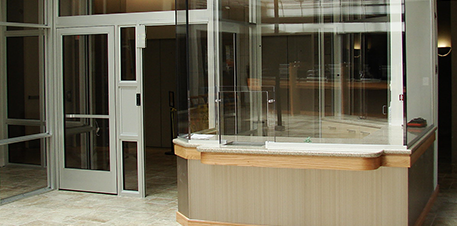There’s increased interest in municipal infrastructure security—especially for higher-security bullet-resistant barrier systems in municipal and local government offices. This is especially the case along the southern border, in Texas, Arizona, and Southern California.
Is this a sign of sinister anti-government trends along the border? Are we in the midst of a worrisome spike in violent crime? Unlikely.
Total Security Solutions has seen similar regional trends in the past. For example, back in 2016, they saw a spike in interest in Texas. At that time, financial institutions were installing barriers in response to an increase in “armed takeover”-style robberies.
At that time, TSS CEO Jim Richards explained that he doubted Texas was any more dangerous than any other state. In fact, Texas wasn’t even in the top 10 that year — and still isn’t today. As Jim noted then: “Typically, when you look at where the country is growing, the demand for bullet-resistant barriers is growing as well. It’s a simple fact of life: people commit crimes, so wherever people go, the crime goes with them.”
The current growth in bullet-resistant barriers and enhanced municipal infrastructure security in the South and Southwest is similar. Four of America’s 10 fastest-growing cities are in Texas alone, and roughly three-fifths of the top 25 fastest growing US cities are located in just three states: Texas, Arizona, and Florida.
“Whether you like it or not, whether it’s legal or illegal, that’s still population. That area is growing, and that’s putting demand on these municipalities to serve those people. Areas that are growing, populations that are growing, they’re bringing in more tax money, they have more money to spend and upgrade security and locations.”
Increasing Levels of Municipal Infrastructure Security
What is changing is the security level administrators and municipal agencies are seeking for their buildings. In the past, most government offices opted for Level 2 or 3 barriers. These are designed to stop many rounds from all of the most common handguns. Today, Jim is predominately seeing cities and administrators looking at Level 3, 4, and 5 systems. Levels 4 and 5 are designed to stop high-powered hunting rifles, tactical rifles, and other assault weapons. Traditionally, transparency-rated Level 4 and above was primarily used for exterior windows, situations with a perceived threat of snipers, or places that also need a blast-or-forced-entry-rated window.
As Jim often explains, “Pretty much any handgun will be stopped by Level 3 bullet resistant materials. The most common pistol calibers can be stopped by Level 1. Does an office need Level 4? Probably not. But if they’ve gotten word of significant, specific threats—then a Level 4 system with steel doors and access control starts to make sense. Recently, we’re seeing probably more Level 4 and 5 than 3 in municipal buildings, and that’s on interior windows.”
Jim doesn’t rule out the need for such high levels of security. But that assumes there is indeed some specific and credible threat that warrants it. But, in general (and especially knowing how strapped for cash many cities and counties are) he reminds people that, despite what you might read in the news, it’s exceedingly unlikely that you’ll need to stop an AK-47. Don’t mind the headlines. Listen to the security professionals who did your audit (likely local law enforcement, in the case of municipal offices), and take action based on their recommendations.
Design and Installation Challenges of Increasing Municipal Infrastructure Security
Some construction companies and contractors struggle with big municipal security installations—especially when they involve bullet-resistant materials. Sometimes those materials require some special preparation and handling for proper installation.
This can also be the case with renovations, which always add further complications. “You’re dealing with existing environments,” Jim says. “So you’re really kinda constrained by what they’ve cobbled together over the years. I think some bulletproof companies, some installers really struggle with that. Over the years of doing this, our team has really become exceptional at weaving in between those constraints to give our customers the best infrastructure security improvements and solutions.”


